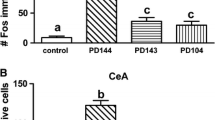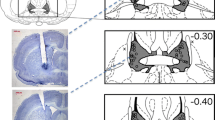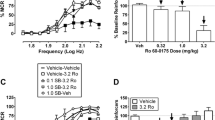Abstract
Some non-selective serotonin2C (5-HT2C) agonists or inverse agonists enhance the product of the proto-oncogene c-Fos within the basal ganglia, a group of brain regions involved in motor behavior and in the ability of these drugs to promote abnormal movements. The role of 5-HT2C receptors in these effects is unclear. The 5-HT2C antagonist SB243,213 (1 mg/kg), which enhanced Fos per se in the striatum and the subthalamic nucleus (STN) only, was used to study the implication of 5-HT2C receptors. The agonists Ro 60-0175 (3 mg/kg) and m-CPP (1 mg/kg) and the inverse agonist SB206,553 (10 mg/kg) enhanced Fos expression in the STN and faintly in the entopeduncular nucleus (EPN, the internal globus pallidus in primate). The effects of these drugs differed mainly in the striatum regarding the magnitude (m-CPP > Ro 60-0175> SB243,213 > SB206,553) or the striatal quadrants (faint to no labeling in lateral striatum) and in the substantia nigra. None of these compounds enhanced Fos expression by themselves in the globus pallidus or in the EPN when combined with SB243,213. Their Fos effect in the STN was reduced significantly by SB243,213 only in the case of m-CPP. In the ventromedial striatum, SB243,213 reduced the effects of m-CPP while SB206,553 reduced the effects of SB243,213. The results show that opposite pharmacological agents alter similarly Fos expression in the EPN or the STN. Although some of the effects of 5-HT agents are related to targets other than 5-HT2C receptors, the study confirms the existence of multiple 5-HT2C receptor-dependent controls recruited by these drugs upon basal ganglia activity.





Similar content being viewed by others
Abbreviations
- 5-HT:
-
5-hydroxytryptamine (serotonin)
- 5-HT2C receptor:
-
Serotonin2C receptor
- m-CPP:
-
Meta-chlorophenylpiperazine dihydrochloride
- Ro 60-0175:
-
S-2-(6-chloro-5-fluoroindol-1-yl)-1-methylethylamine
- SB243,213:
-
5-Methyl-1-[[2-[(2-methyl-3-pyridyl)oxy]-5-pyridyl]carbamoyl]-6-trifluoromethylindoline
- SB206,553:
-
5-methyl-1-(3-pyridylcarbamoyl)-1,2,3,5-tetrahydropyrrolo[2,3-f]indole hydrochloride
- STN:
-
Subthalamic nucleus
- EPN:
-
Entopeduncular nucleus
- GPe:
-
External globus pallidus
- SNr:
-
Substantia nigra pars reticulata
- DM:
-
Dorsomedial
- DL:
-
Dorsolateral
- VM:
-
Ventromedial
- VL:
-
Ventrolateral
- PB:
-
Phosphate buffer
- PBS:
-
Phosphate buffered saline
References
Alex KD, Yavanian GJ, McFarlane HG, Pluto CP, Pehek EA (2005) Modulation of dopamine release by striatal 5-HT2C receptors. Synapse 55(4):242–251
Alexander GE, Crutcher MD (1990) Functional architecture of basal ganglia circuits: neural substrates of parallel processing. Trends Neurosci 13(7):266–271
Belforte JE, Pazo JH (2004) Turning behaviour induced by stimulation of the 5-HT receptors in the subthalamic nucleus. Eur J Neurosci 19(2):346–355
Berg KA, Navailles S, Sanchez TA, Silva YM, Wood MD, Spampinato U, Clarke WP (2006) Differential effects of 5-methyl-1-[[2-[(2-methyl-3-pyridyl)oxyl]-5-pyridyl]carbamoyl]-6-trifluoro methylindone (SB 243213) on 5-hydroxytryptamine(2C) receptor-mediated responses. J Pharmacol Exp Ther 319(1):260–268
Beyeler A, Kadiri N, Navailles S, Boujema MB, Gonon F, Moine CL, Gross C, De Deurwaerdere P (2010) Stimulation of serotonin2C receptors elicits abnormal oral movements by acting on pathways other than the sensorimotor one in the rat basal ganglia. Neuroscience 169(1):158–170
Dalton GL, Lee MD, Kennett GA, Dourish CT, Clifton PG (2004) mCPP-induced hyperactivity in 5-HT2C receptor mutant mice is mediated by activation of multiple 5-HT receptor subtypes. Neuropharmacology 46(5):663–671
Damjanoska KJ, Muma NA, Zhang Y, D’Souza DN, Garcia F, Carrasco GA, Kindel GH, Haskins KA, Shankaran M, Petersen BR, Van De Kar LD (2003) Neuroendocrine evidence that (S)-2-(chloro-5-fluoro-indol- l-yl)-1-methylethylamine fumarate (Ro 60–0175) is not a selective 5-hydroxytryptamine(2C) receptor agonist. J Pharmacol Exp Ther 304(3):1209–1216
De Deurwaerdere P, Chesselet MF (2000) Nigrostriatal lesions alter oral dyskinesia and c-Fos expression induced by the serotonin agonist 1-(m-chlorophenyl) piperazine in adult rats. J Neurosci 20(13):5170–5178
De Deurwaerdere P, Spampinato U (2001) The nigrostriatal dopamine system: a neglected target for 5-HT2C receptors. Trends Pharmacol Sci 22(10):502–504
De Deurwaerdere P, Navailles S, Berg KA, Clarke WP, Spampinato U (2004) Constitutive activity of the serotonin2C receptor inhibits in vivo dopamine release in the rat striatum and nucleus accumbens. J Neurosci 24(13):3235–3241
De Deurwaerdere P, Le Moine C, Chesselet MF (2010) Selective blockade of serotonin 2C receptor enhances Fos expression specifically in the striatum and the subthalamic nucleus within the basal ganglia. Neurosci Lett 469(2):251–255
De Deurwaerdere P, Lagiere M, Bosc M, Navailles S (2013) Multiple controls exerted by 5-HT2C receptors upon basal ganglia function: from physiology to pathophysiology. Exp Brain Res. doi:10.1007/s00221-013-3508-2
Eberle-Wang K, Lucki I, Chesselet MF (1996) A role for the subthalamic nucleus in 5-HT2C-induced oral dyskinesia. Neuroscience 72(1):117–128
Eberle-Wang K, Mikeladze Z, Uryu K, Chesselet MF (1997) Pattern of expression of the serotonin2C receptor messenger RNA in the basal ganglia of adult rats. J Comp Neurol 384(2):233–247
Fox SH, Moser B, Brotchie JM (1998) Behavioral effects of 5-HT2C receptor antagonism in the substantia nigra zona reticulata of the 6-hydroxydopamine-lesioned rat model of Parkinson’s disease. Exp Neurol 151(1):35–49
Gobert A, Rivet JM, Lejeune F, Newman-Tancredi A, Adhumeau-Auclair A, Nicolas JP, Cistarelli L, Melon C, Millan MJ (2000) Serotonin(2C) receptors tonically suppress the activity of mesocortical dopaminergic and adrenergic, but not serotonergic, pathways: a combined dialysis and electrophysiological analysis in the rat. Synapse 36(3):205–221
Higgins GA, Fletcher PJ (2003) Serotonin and drug reward: focus on 5-HT2C receptors. Eur J Pharmacol 480(1–3):151–162
Hughes P, Dragunow M (1995) Induction of immediate-early genes and the control of neurotransmitter-regulated gene expression within the nervous system. Pharmacol Rev 47(1):133–178
Javed A, Van de Kar LD, Gray TS (1998) The 5-HT1A and 5-HT2A/2C receptor antagonists WAY-100635 and ritanserin do not attenuate D-fenfluramine-induced fos expression in the brain. Brain Res 791(1–2):67–74
Kadiri N, Lagiere M, Le Moine C, Millan MJ, De Deurwaerdere P, Navailles S (2012) Diverse effects of 5-HT(2C) receptor blocking agents on c-Fos expression in the rat basal ganglia. Eur J Pharmacol. doi:10.1016/j.ejphar.2012.05.022
Kahn RS, Wetzler S (1991) m-Chlorophenylpiperazine as a probe of serotonin function. Biol Psychiatry 30(11):1139–1166
Kita H, Chiken S, Tachibana Y, Nambu A (2007) Serotonin modulates pallidal neuronal activity in the awake monkey. J Neurosci 27(1):75–83. doi:10.1523/JNEUROSCI.4058-06.2007
Lagiere M, Navailles S, Bosc M, Guthrie M, De Deurwaerdère P (2013a) Serotonin2C receptors and the motor control of oral activity. Curr Neuropharm 11(2):160–170
Lagiere M, Navailles S, Mignon L, Roumegous A, Chesselet MF, De Deurwaerdere P (2013b) The enhanced oral response to the 5-HT agonist Ro 60–0175 in parkinsonian rats involves the entopeduncular nucleus: electrophysiological correlates. Exp Brain Res. doi:10.1007/s00221-013-3478-4
Leslie RA, Moorman JM, Coulson A, Grahame-Smith DG (1993) Serotonin2/1C receptor activation causes a localized expression of the immediate-early gene c-fos in rat brain: evidence for involvement of dorsal raphe nucleus projection fibres. Neuroscience 53(2):457–463
Lucas JJ, Segu L, Hen R (1997) 5-Hydroxytryptamine1B receptors modulate the effect of cocaine on c-fos expression: converging evidence using 5-hydroxytryptamine1B knockout mice and the 5-hydroxytryptamine1B/1D antagonist GR127935. Mol Pharmacol 51(5):755–763
Martin JR, Bos M, Jenck F, Moreau J, Mutel V, Sleight AJ, Wichmann J, Andrews JS, Berendsen HH, Broekkamp CL, Ruigt GS, Kohler C, Delft AM (1998) 5-HT2C receptor agonists: pharmacological characteristics and therapeutic potential. J Pharmacol Exp Ther 286(2):913–924
Mehta A, Eberle-Wang K, Chesselet MF (2001) Increased m-CPP-induced oral dyskinesia after lesion of serotonergic neurons. Pharmacol Biochem Behav 68(2):347–353
Millan MJ (2005) Serotonin 5-HT2C receptors as a target for the treatment of depressive and anxious states: focus on novel therapeutic strategies. Therapie 60(5):441–460
Nambu A (2008) Seven problems on the basal ganglia. Curr Opin Neurobiol 18(6):595–604
Navailles S, De Deurwaerdere P (2011) Presynaptic control of serotonin on striatal dopamine function. Psychopharmacology 213(2–3):213–242
Navailles S, Moison D, Ryczko D, Spampinato U (2006) Region-dependent regulation of mesoaccumbens dopamine neurons in vivo by the constitutive activity of central serotonin2C receptors. J Neurochem 99(4):1311–1319
Navailles S, Lagiere M, Guthrie M, De Deurwaerdere P (2013a) Serotonin2C receptor constitutive activity: in vivo direct and indirect evidence and functional significance. Central nervous system agents in medicinal chemistry
Navailles S, Lagiere M, Roumegous A, Polito M, Boujema MB, Cador M, Dunlop J, Chesselet MF, Millan MJ, De Deurwaerdere P (2013b) Serotonin2C ligands exhibiting full negative and positive intrinsic activity elicit purposeless oral movements in rats: distinct effects of agonists and inverse agonists in a rat model of Parkinson’s disease. Int J Neuropsychopharmacol 16(3):593–606. doi:10.1017/S1461145712000417
Paxinos G, Watson C (1998) The rat brain in stereotaxic coordinates, 4th edn. Academic Press, San Diego
Rueter LE, Tecott LH, Blier P (2000) In vivo electrophysiological examination of 5-HT2 responses in 5-HT2C receptor mutant mice. Naunyn Schmiedebergs Arch Pharmacol 361(5):484–491
Sgambato V, Abo V, Rogard M, Besson MJ, Deniau JM (1997) Effect of electrical stimulation of the cerebral cortex on the expression of the Fos protein in the basal ganglia. Neuroscience 81(1):93–112
Singewald N, Salchner P, Sharp T (2003) Induction of c-Fos expression in specific areas of the fear circuitry in rat forebrain by anxiogenic drugs. Biol Psychiatry 53(4):275–283
Stanford IM, Kantaria MA, Chahal HS, Loucif KC, Wilson CL (2005) 5-Hydroxytryptamine induced excitation and inhibition in the subthalamic nucleus: action at 5-HT(2C), 5-HT(4) and 5-HT(1A) receptors. Neuropharmacology 49(8):1228–1234
Stark JA, Davies KE, Williams SR, Luckman SM (2006) Functional magnetic resonance imaging and c-Fos mapping in rats following an anorectic dose of m-chlorophenylpiperazine. Neuroimage 31(3):1228–1237
Tremblay PO, Gervais J, Rouillard C (1998) Modification of haloperidol-induced pattern of c-fos expression by serotonin agonists. Eur J Neurosci 10(11):3546–3555
Wirtshafter D, Cook DF (1998) Serotonin-1B agonists induce compartmentally organized striatal Fos expression in rats. NeuroReport 9(6):1217–1221
Wood MD, Reavill C, Trail B, Wilson A, Stean T, Kennett GA, Lightowler S, Blackburn TP, Thomas D, Gager TL, Riley G, Holland V, Bromidge SM, Forbes IT, Middlemiss DN (2001) SB-243213; a selective 5-HT2C receptor inverse agonist with improved anxiolytic profile: lack of tolerance and withdrawal anxiety. Neuropharmacology 41(2):186–199
Xiang Z, Wang L, Kitai ST (2005) Modulation of spontaneous firing in rat subthalamic neurons by 5-HT receptor subtypes. J Neurophysiol 93(3):1145–1157
Zhang QJ, Liu X, Liu J, Wang S, Ali U, Wu ZH, Wang T (2009) Subthalamic neurons show increased firing to 5-HT2C receptor activation in 6-hydroxydopamine-lesioned rats. Brain Res 1256:180–189
Acknowledgments
This work was supported by grants from Centre National de la Recherche Scientifique and Bordeaux 2 University. Professor P. De Deurwaerdère received support from the European cooperation in science and technology (COST action CM1103). Mélanie Lagière is a fellowship recipient from the Ministère de la Recherche et de l’Enseignement Supérieur.
Author information
Authors and Affiliations
Corresponding author
Additional information
S. Navailles and M. Lagière have equally contributed to this work.
Rights and permissions
About this article
Cite this article
Navailles, S., Lagière, M., Le Moine, C. et al. Role of 5-HT2C receptors in the enhancement of c-Fos expression induced by a 5-HT2B/2C inverse agonist and 5-HT2 agonists in the rat basal ganglia. Exp Brain Res 230, 525–535 (2013). https://doi.org/10.1007/s00221-013-3562-9
Received:
Accepted:
Published:
Issue Date:
DOI: https://doi.org/10.1007/s00221-013-3562-9




